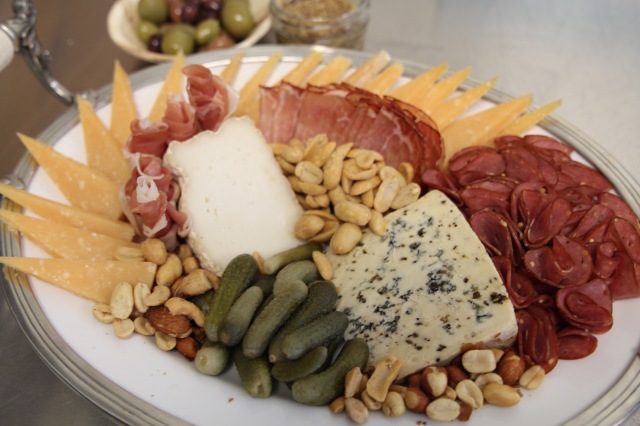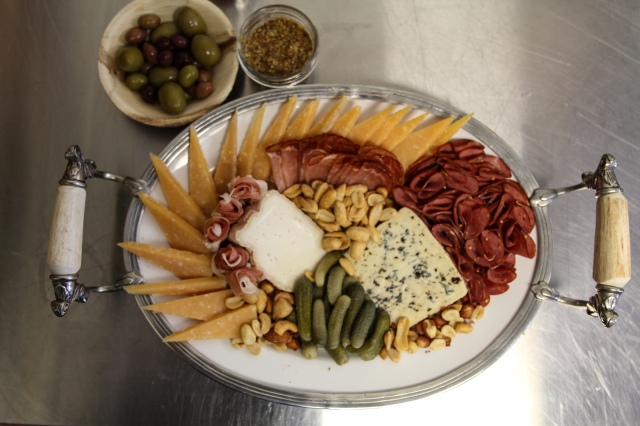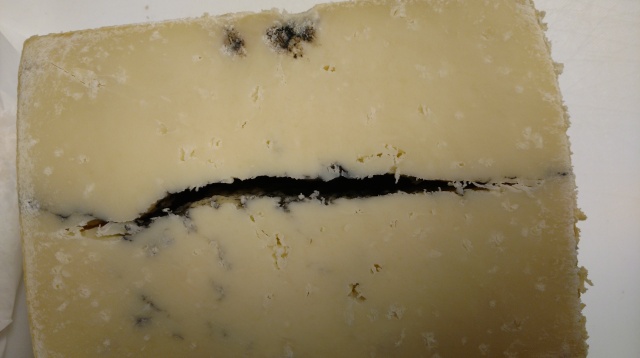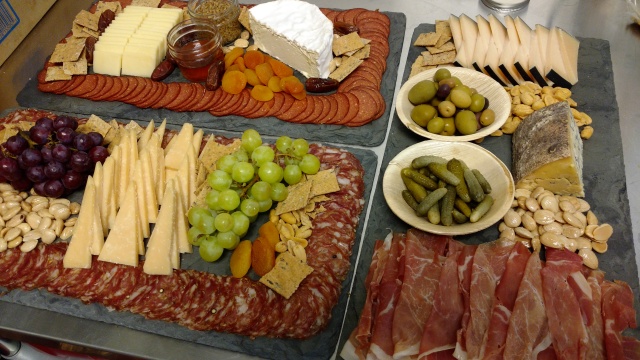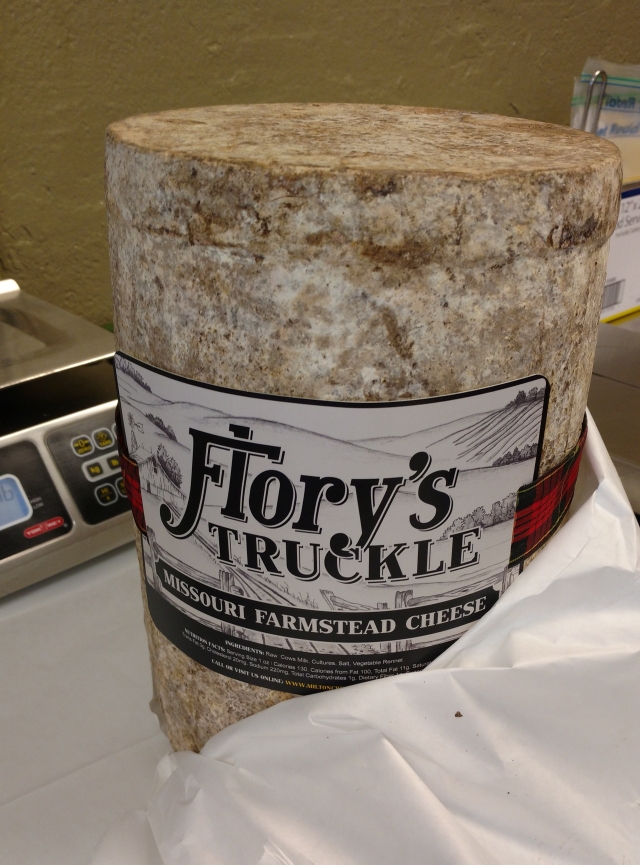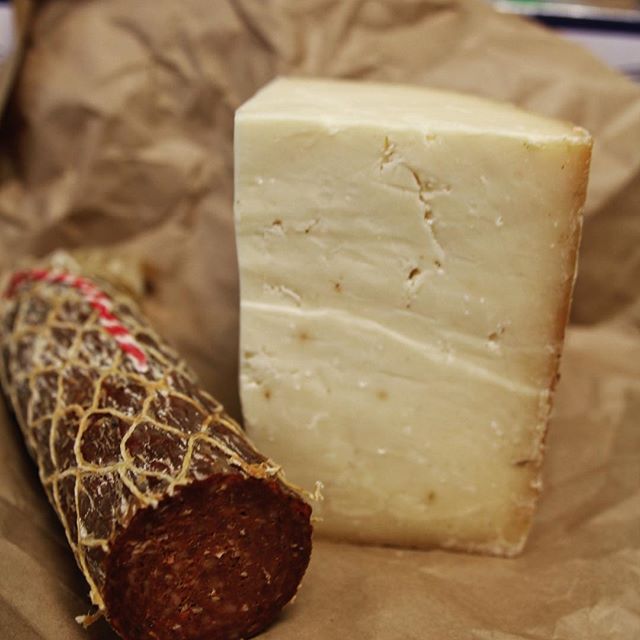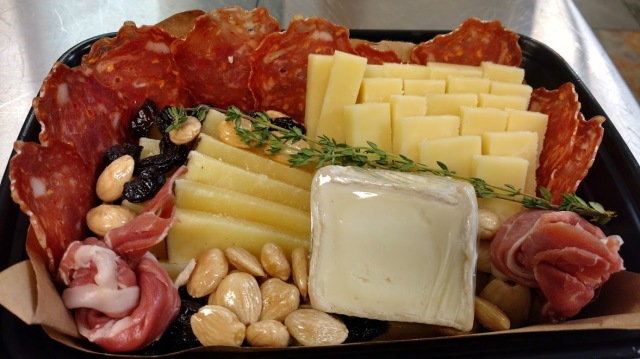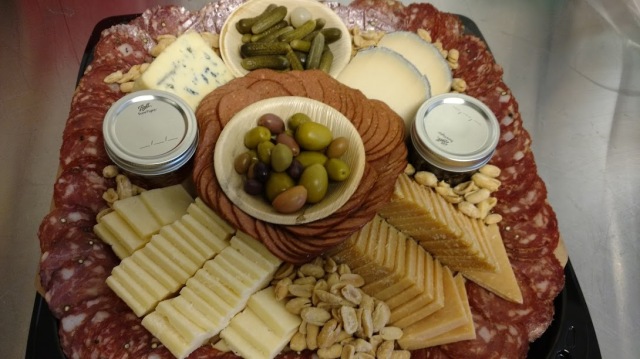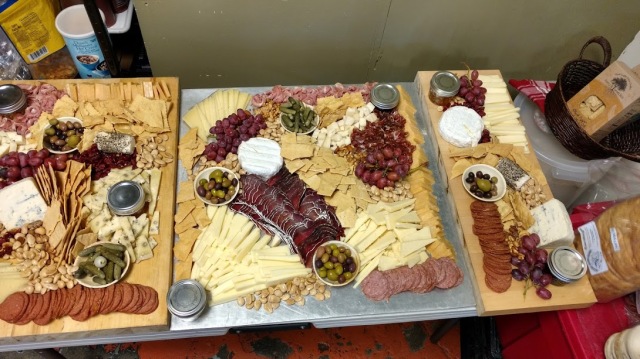One of the many reasons some customers feel a bit intimidated at the cheese counter is that they see so many words they don’t recognize and can’t pronounce with any confidence. We see not only among European/world cheeses, but also among American cheeses, words rooted in multiple languages, such that hazarding a guess as to their pronunciation feels like offering oneself up for ridicule. I’ll bet real money that some customers decide—consciously or otherwise–not to even try a particular cheese at my counter because they fear pronouncing it wrong and being laughed at. I want to say this loud and clear: anyone implying that he or she is more sophisticated than someone else because they know (or think they know) how to pronounce a foreign word is full of bologna. They probably pronounce bologna in a pretentious way, too.
My experience suggests that people fall into just a few categories when faced with this dilemma. Some say, “screw it, I guess I’ll just ask for cheddar.” Some show off their French or Italian or Spanish or Dutch or German skills and ask to try a cheese using a pronunciation that may (or may not?) be perfect in the language of origin (which sometimes results in a confused look on my own face, not being well-versed in any of those languages myself). More aggressive types barge ahead confidently with ridiculous pronunciations, usually accompanied by an accent they invented and a story about a Spanish hostel they lived in for a week in 1972: “I’d like to try the MoonchuGAA, please! I’ll bet it’s crap compared to the real thing I had in Madrid!” If I can figure out what they’re trying to say, I’ll grab it without daring to challenge their “expertise.” More modest types tend to say something like, “ooh, this one looks interesting, but… how do you say that… man-che-go?”
I’d like to make a few (hopefully helpful) remarks about this topic from the perspective of someone who faces this dilemma himself and watches others try to navigate it five days a week. Then, I’d like to offer some safe bets for pronouncing common cheese words in an American context. (For the record, I can’t use International Phonetic Alphabet symbols here, nor would I if I could, so I’m just trying to spell pronunciations in a way that I hope best reflects the sounds for English speakers. The result is imprecise, but that’s perhaps for the best. My post in general suggests that imprecision is normal and acceptable.)
- There’s no reason to be bashful in front of your cheesemonger. For one thing, you make more money than we do and have made better life choices. Congrats! If we were fluent in seven languages, we’d likely not be working a cheese counter. (Then again, a PhD in English didn’t keep me away from cheesemongering, so hey, maybe we just like it, and that shouldn’t be very intimidating either.) Cheese words show up from many languages and no one expects you to know them all. Cheesemongers mispronounce stuff all the time. I’ve done it more often than I’d care to admit. It’s fine. I’ve never once—not one time—made fun of a customer for not knowing how to pronounce a word. I HAVE, I’ll admit, chuckled heartily behind the backs of customers who came up with bizarre, inexplicable pronunciations I could never have dreamed of, pronunciations seemingly unrelated to the letters in the word and wholly distinct from any pronunciation any other human has uttered, and then seemed miffed that I was too dumb to recognize their unique creation. I mean, c’mon. That’s hilarious. My chuckling is at the expense of their arrogance rather than their ignorance. But here’s a truly shameful confession: one time I was sharing a laugh with a coworker after a customer had said MORE THAN ONCE, “PARE-uh-KEEN-yo” in an effort, as I finally deduced, to pronounce Pecorino. Same thing happened when a customer insisted on “pare-uh-MEES-ee-un” cheese. I felt pretty bad about it later when I considered that perhaps the customer might be dyslexic. Oof. Sorry, universe. I’m awful. So, I guess what I should have said is there’s no reason to be bashful in front of your cheesemonger unless he or she is a jerk like I was that one time. Ok, two times. But, truly, it’s 100% ok to not know how to pronounce a cheese word. I’m pretty terrible with the French cheese words myself.
- Often, it’s not a matter of there being a universally standard, correct and incorrect pronunciation. It’s just about communicating what you want. For a given foreign cheese word, there are likely multiple pronunciations, each of which is correct or close enough in a given context. For example: mozzarella. Americans pronounce it one way (usually MAHT-suh-RELL-uh). Italians pronounce it another way (something like MOATZ-zah-RELL-luh). Italian-Americans of the American northeast tend to drop the final vowels of Italian words (moat-zah-RELL). Those all work perfectly fine, don’t they? If I were in Italy, trying my best to order in Italian, I’d give the Italian pronunciation my best effort, but here in the US of A, I say MAHT-suh-RELL-uh or just MAHZ. Am I embarrassed that I don’t pronounce it in the most Italian way possible? Not even a little bit. I’d argue that the American pronunciation is, well, the American pronunciation—perfectly correct in the US. If you pronounce it the Italian way, that’s cool (even if a bit silly for non-Italians), but it’s not going to earn you a discount. Also, for some perspective, keep in mind that even words you think you know how to pronounce in your own language are pronounced differently elsewhere in your own language. Among native English speakers, ten can be pronounced TIN or TEN. Roof can be ROOF or RUF. A word as simple as car is pronounced differently in London than in Boston than in Nashville. So let’s not be too judgy. This stuff is Linguistics 101. It’s all okay.
- Some cheese words are funny! It’s ok to giggle! Butterkäse, Muenster, Scharfe Maxx! Challerhocker, Challerhocker, Challerhocker! (I CANNOT say Scharfe Maxx without using a Schwarzenegger voice and tee-hee-ing.)
- It’s ALWAYS okay to ask for the pronunciation or just avoid it altogether: “I’d like to try this cheese at the far left with the white rind, the one on the second row, please.” It’s not like it won’t be delicious if you can’t pronounce the name. You could even spell it out if that helps. “How do you say the name of this one at the top that starts with c-h?” Sometimes I’m selling a new cheese and have to admit that I don’t know how to pronounce it either. I’ll look it up eventually, but in the meantime, I’m not all that worried about it. Some of the names are made up, so there is no standard pronunciation. IT’S OKAY.
- Remember, we cheesemongers LOVE teaching customers about cheese. I’m every bit as excited about working with a customer who knows very little about cheese as a customer with sophisticated cheese knowledge. Don’t worry about it. It’s not like a car lot where you might get swindled if you haven’t done your research. We’re glad you’re at the counter either way, and we want to help! If you admit that you’ve never tried Manchego and don’t know how to pronounce it, hey, great! That’s an opportunity for me to tell you all about it and introduce you to one of my favorite cheeses of all time! I’ll walk you through it with glee. We’ll have a taste together and then grin stupidly. It’s great.
- Using words from one language in another language always requires some compromise. The phonemes are different. The cadences are different. English speakers don’t necessarily know how to make all the necessary sounds of another language. (I can’t roll my Rs and my gutterals are rubbish, for example, because, after all, those sounds aren’t used in the language I speak!). And that’s okay! We just want to understand each other. “Close enough to be understood” is my rule here. Not pretentiously making up dumb stuff is my other rule.
- It’s just cheese. You don’t have to know anything. You can just be like, “let me try something mind-blowingly delicious” and we’ll taste cheeses until you fall in love with something.
- You’re not the only person who’s stumped. I just did some super-basic Googling to look at other cheese pronunciation guides, and guess what: even the people presenting themselves as experts get this stuff mind-bendingly wrong on a mind-bogglingly regular basis. I mean, I saw a high-production-cost video that not only mispronounced but also friggin’ misspelled Parmigiano Reggiano while presuming to teach me how to say the term. So, my approach is necessarily loose and lenient. I just want us to all feel like we’re not dummies when we talk about cheese and to forgive each other’s differences because, guess what, guy-who-thinks-his two-semesters-of-French-makes-him-an-expert: people pronounce words differently and that’s okay because it’s how language works, always and forever.
Now for the informational portion of this broadcast. It’s either the part you scrolled down to immediately or the part you’ll skip. For your pleasure and (mis)education, here’s a list of some cheese words and their common American pronunciations (with alternatives as necessary):
ASIAGO: AH-see-AH-go. If you say this in a way that makes it sound like you’re about to name all the continents, you might wanna try again.
BLEU: This is the French word for blue. They say something like BLUH. But, you know, this is a word we can just as easily translate to English because WE HAVE AN ENGLISH COGNATE FOR THAT and it’s blue. I don’t know. Take your pick. BLUH or BLOO. They both sound kinda silly when you think about it.
BRIE: BREE. It’s unbrielievably easy.
CAMEMBERT: CAM-um-bear. Don’t say the t. In French, the middle vowel is more open, more like an OH or AH, and the R is barely audible (to my ear, anyway).
CHALLERHOCKER: HALL-ur-hock-ur. Were you Swiss, you’d pronounce the Ch with a guttural sound. (I recently impressed a Swiss customer by using the guttural sounds appropriately, but never told her that I was actually using a phoneme I learned in Hebrew class as my best approximation. Close enough!)
CHÈVRE: Fresh goat’s milk cheese is called SHEV or SHEV-ruh. I’ve heard the French pronunciation, but I can’t say it properly. Sorry, not sorry. I’m a cheesemonger, not an expert in the French language. I call it SHEV, which is perfectly common and acceptable in the US.
COMTÉ: I swear, I don’t know. Might be LAW-rul, might be YAH-nee. No one knows. I’ve heard, like, twelve ways to pronounce this very short word. I DON’T KNOW. I say COM-tee, which is wrong. And I’m not even embarrassed. But if you wanna correct me, please do so. (Just know that someone else will “correct” me in a wholly different direction.) I think it’s actually something along the lines of COHM-tuh with a barely-there final syllable.
CRÈME FRAîCHE: CREM FRESH. Not as tricky as it looks.
FETA: Americans think they’re saying FET-uh, but they’re usually saying FEH-duh. That’s fine, I suppose (I can just barely hear the difference, to be honest), but it does seem to rub Greeks the wrong way. They keep correcting me. Sorry. One very kind Greek customer told me in the gentlest possible way that Greek customers would really appreciate me if I would say it the right way, which is apparently something like FET-TAH.
FROMAGE: froh-MAJ. (The J is more JH—a vocalized SH—I can’t quite spell it in a way that reflects the sound: think of the z in azure.) It’s fro like fro-yo and mage like Taj Mahal. Look, French doesn’t even accent syllables, so that’s an example of the transliteration problem I’m pointing out here. If you don’t speak French, you don’t have to say these words as if you do (you probably can’t anyway). And if you’re bilingual in French and English, use context to determine which language to use. Sure, it might be a little embarrassing to say fruh-MAG-ur, but, you know, let’s just get close-ish so we can understand each other. BTW, fromage just means cheese.
GOUDA: GOO-duh. Every now and then, a customer will correct me. I’m not unaware that the Dutch say HOW-duh (with a guttural H), but a) that guttural H phoneme isn’t part of my speech—I couldn’t do it properly if I wanted to—and b) Americans call it GOO-duh. Likewise, Americans pronounce the French capitol city PARE-iss rather than pah-REE (with some kind of deep-throated R that I can’t do). It’s okay. That’s how language works. It changes with time and place. No worries. Just don’t call it GOW-duh. You’re thinking of an inflammatory disease.
GRUYERE: Americans tend to say groo-YAIR, while Brits say gree-YAIR. I, for reasons unknown even to myself, use the British pronunciation. I think I’m afraid Gordon Ramsay will yell at me if I say it a different way.
HAVARTI: huh-VAR-tee or, if you wanna get real American about it, huh-VAR-dee.
KASE: KAY-zuh. You’ll see this term as part of many German or Swiss cheese names, like Butterkäse or Sennenkase. (Btw, I’ll accept BUT-ur-kay-zuh or BOOT-ur-kay-zuh, the latter being a little closer to the original. Hell, even if you say BUT-ur-case, I’ll know what you mean, and that’s fine.) Käse is just the German word for cheese.
MANCHEGO: man-CHAY-go or mahn-CHAY-go. I often hear Americans say man-CHAIN-go, and I know this goes against my basic principles here, but I have to draw the line at that one. There’s just no reason to add a second n. In Spanish, the second syllable is more CHE than CHAY. I don’t care.
MASCARPONE: mah-skar-POH-neh or mah-skar-POH-nay. But many Americans, including Italian-Americans, say MAR-skuh-pone, and I don’t really understand why, but it’s common enough that I’m fine with it. If it’s good enough for Tony Soprano, it’s good enough for me.
MUENSTER: MUN-stir. The “u” can sound like that in “cut” or in “push.” Close enough either way.
OSSAU-IRATY: Hell if I know. Just kidding. It’s oh-so-EER-ah-tee. Because CLOSE ENOUGH.
PARMIGIANO REGGIANO: PARM. Seriously, that’s fine. I often say PARM REJ to indicate I’m talking about the real Reggiano rather than some other parm-like cheese. The more authentic pronunciation, if you wanna know, is par-mee-JAH-no rej-JAH-no. When Italian words include double-letters, those letters are sort of lengthened across two syllables, included in both the end of one syllable and the beginning of the next. But you don’t need to know that to order cheese.
PECORINO ROMANO: peh-co-REE-no roh-MAH-no. FYI: Pecorino just means sheep cheese. Romano means Roman. So Pecorino Romano is sheep cheese in the Roman (southern Italian) style. Likewise, Pecorino Toscano is sheep cheese from Toscano, or northern Italy (Tuscany, we say in English). And the cheekily-named Pecorino Wiscono is sheep cheese from Wisconsin.
PROVOLONE: Americans say PRO-vuh-lone, and I’d say that’s correct for American-made deli cheese in (very roughly) the style of Provolone. But if I’m feeling fancy, I’ll call real Italian Provolone by its name: pro-voh-LOH-neh.
RICOTTA: Americans say rih-COT-uh. That’s fine. Italians say ree-COAT-tah.
ROQUEFORT: ROKE-fore or ROKE-fort. The former is closer to the French and considered more “correct,” but Americans often pronounce the T and that doesn’t bother me for even a second. If you wanna be real French and put some guttural R stuff in there, go for it.
TALEGGIO: tah-LEJ-jee-oh or, more Americanly, tuh-LEJ-ee-oh. I’m pretty sure I say the latter.
TOMME: TOM (like the name short for Thomas) or TUM. You’ll also hear TOME and tome-AY. Basically, Americans haven’t decided how to handle this one. I say TOM. To me, TUM sounds pretentious, TOME is a long book, and tome-AY is trying way too hard, especially considering that the French word is only one syllable. But it’s a free-for-all. Do as you please.
Did I miss an important one? Lemme know. Most importantly, get thee to the fromagerie and put so much cheese in your mouth that you can’t pronounce any words at all!
